My Thoughts on Woody
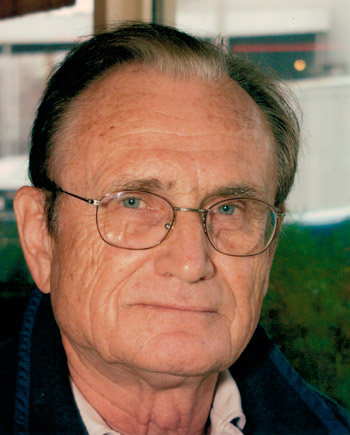 This is not an obituary. These are just some of my recollections of things Woody told me, or wrote to me over the years, and my remembrances of the times we spent together.
This is not an obituary. These are just some of my recollections of things Woody told me, or wrote to me over the years, and my remembrances of the times we spent together.
Nathan Rosser “Woody” Woodward, universally acknowledged as the founder and most prolific researcher of the insulator collecting hobby, died on August 6, 2019 at the age of ninety-one in a nursing home in Houston, Texas.
He was relatively healthy, although he did suffer the frailty and weakness of age. Over the last few years both his short and long-term memory declined. When I last spoke with him in September 2018, eleven months before his death, neglecting his memory lapses, it would have been difficult to tell he had any degree of impairment. We had a lively conversation and it seemed as if I were talking to the same old Woody I had known ten years before. I am told he was still lucid and pleasant to the end. He enjoyed playing Bingo with the other residents, often winning, and a game called Trivia with his aide.
On the evening of August 6, he complained of some chest pain, lost consciousness and was gone. I hope that when my time comes, or yours for that matter, we are as fortunate.
N. R. Woodward authored five books:
The Glass Insulator in America 1865-1965 Progress Report
The Glass Insulator in America 1967 Report
The Glass Insulator in America 1969 Report
The Glass Insulator in America 1973 Report
The Glass Insulator in America 1988 Report (re-published with minor changes and additional drawings in 1998)
He co-authored two books with Marylin Albers:
Glass Insulators from Outside North America, First Revision 1986
Glass Insulators from Outside North America, Second Revision 1993
He wrote dozens of articles for insulator magazines and answered hundreds of letters from collectors throughout the years.
Woody and I were close friends for about fifteen years beginning in 1994 when I entered the insulator hobby. I always called him “Woodwardo.” My knowledge of insulators at that time, and indeed even more so today, is rather limited.
Woody however possessed an encyclopedic knowledge of the subject. He acquired it over six decades of continuous research; walking the lines; riding the rails; and spending thousands of hours in dozens of libraries throughout the country, particularly those with U.S. Patent Office collections. He would speak or correspond with anyone he could locate who might have information about insulators such as insulator manufactures, manufacturing techniques, or anything related to this arcane subject.
While Woody was interested in insulators since the age of two, he began his life-long research in earnest in 1950. Unfortunately, Woody was promptly drafted into the Army and had to curtail his interest until his discharge in 1952. This was the dark age of the hobby, as well as the world as we now know it.
Telephone calls in search of information were generally unproductive. Companies and people in the trade generally did not have the time or inclination to talk on the phone answering questions that were not directly related to the advancement of their business interests. Also, Long Distance charges were metered in dollars per minute. If you wanted information, you wrote or visited. Woody did a great deal of both.
There was no fax. There was no internet. There was no Google. The search engine back then was the local public library. Copy machines were rare until well into the 1970’s, and even then, they cost ten to twenty-five cents per page; not an inconsequential sum when the hourly minimum wage in 1977 was $2.30.
If you wanted a document you had to search it out, often by going to libraries in towns connected with the object of your search. Reference librarians all over the country knew N. R. Woodward by face, or through repeated correspondence.
Through these, and other hardships, N. R. Woodward managed to view thousands of documents; tens of thousands of insulators; make incredibly detailed notes and drawings of thousands of them; develop from this research the Consolidated Design classification system; and amass the largest collection of documentation concerning insulators and associated related information in the world. The World. Not the Library of Congress, where Mr. Woodward did research. Not Corning’s Museum of Glass, where Mr. Woodward did extensive research, and donated insulators and documents to the museum that were not in their collection. Those weren’t the places you called when you had a question about an insulator. You called Woody. If he couldn’t answer your question outright, he would get to work researching the question and hopefully would find an answer.
N.R. Woodward’s extensive files are now under the care of Dario DiMare of Northborough, MA. Mr. DiMare is undertaking the arduous task of scanning and properly indexing the files so that they will be available for future research by the insulator community.
Mr. DiMare is also Mr. Woodward’s successor administrator of the Consolidated Design system, and the only individual authorized by Mr. Woodward to make any changes to the CD assignments. An undoubtedly thankless task for which I thank him.
In addition to Mr. Woodward’s desire that Mr. DiMare continue to administer and modify the Consolidated Design system as he deems necessary, he also sold Mr. DiMare the exclusive Copyright to the Consolidated Design system, and all other Copyrights, and intellectual property rights Mr. Woodward owned.
Until 1961 Woody believed that he was the only person who had a serious interest in collecting, let alone researching insulators. He had actively been doing this for nine years and had yet to meet anyone else with a similar interest. While doing research in Denver’s Central Library, Woody was informed by a librarian that there was a man named Campbell who lived in town and was also interested in insulators. She and another librarian took the phone book and, starting from opposite ends of all the Campbells listed, proceeded to call each until they found AIbert “Al” R. Campbell. I have no doubt that reference librarians today are as good or better than they were fifty years ago, and would be just as eager to help, but where would they find a phone book?
Of the thousands of collectors Woody has met over the years Al Campbell was the first. They maintained a close friendship until Al’s death.
Mr. Campbell was a lineman for “The Mountain States Telephone and Telegraph Company,” which was commonly referred to as “Mountain States Telephone.” It was re-named “Mountain Bell” in 1969.
Al initially confined his insulator collecting to glass produced in the Denver area. Later, as the hobby became more established, he collected all glass. He always regretted having ignored the thousands of insulators he encountered in his early years simply because they were not Denver products.
Al Campbell died on December 2, 1982. In 1985, his widow, Anna donated Al’s insulator collection to the Lyons Redstone Museum, in Lyons, Colorado. (Ms. Johnson reported to me in an email, that Mr. Campbell, “worked putting up the telephone lines between Lyons and Allenspark, using those glass insulators”.) The collection is on public display and contains 570 pieces, including the only known CD #111 insulator (In 2006 a second CD #111 was discovered and confirmed to be authentic by N. R. Woodward).
Anna donated the collection specifically to keep it available to the public, and out of the hands of private collectors. Anna told Woody that one collector acted particularly inappropriately, attempting to obtain it, “before AI was even in the ground.” The collection is not for sale, so please don’t ask. Anna passed away on December 1, 2005.
Woody spent a pleasant afternoon in August, 1987 with the Director of the Lyons Redstone Museum, LaVern Johnson. Woody had at one time or another, traveled over most of Colorado, and indeed the surrounding country, so they had much to talk about other than insulators.
Woody had a very difficult childhood. He was raised by his mother during the height of the depression, in a small, rural, very non-supportive, religious community. They moved frequently during his childhood. Much like Woody, his mother was a traveler. He told me that “she would just get it into her head that it was time to go, and we would start walking.” He said that it wasn’t unusual for them to walk twenty miles in a day to a relative’s home when he was only a child of six or seven.
When Woody was six, and thereafter, he and his mother would occasionally hop a freight train into Salem or Portland. When Woody told me this, I was shocked; a six-year old riding the rails. He said, “You don’t understand what the times were like. You can’t unless you lived through it. There were fifty or a hundred people on every train that came out of the yard. There were shantytowns all along the rail lines. They were called Hoovervilles. As a child, I lived in them occasionally with my mother. They were dangerous, especially for a woman. People starved. We were just trying to survive.”
Woody’s mother divorced his father shortly after Woody’s birth. Woody’s mother never gave him a reason for the divorce. Woody never met his father.
Woody went to a small church school that did not excel in academic subjects. He finished seventh or perhaps eighth grade. His lack of formal education apparently did nothing to diminish Woody’s writing ability, or other skills requiring higher abstract intellectual thought.
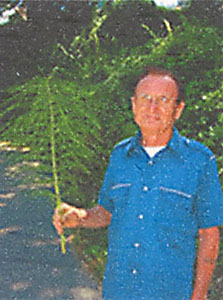 Beside insulators, Woody also had a life-long interest in trees and related flora, an interest that I did not share. In our travels he would constantly point out trees, shrubs, and leaves excitedly telling me about them. I would dutifully nod my head.
Beside insulators, Woody also had a life-long interest in trees and related flora, an interest that I did not share. In our travels he would constantly point out trees, shrubs, and leaves excitedly telling me about them. I would dutifully nod my head.
Woody told me of an incident that occurred when he was perhaps seven. He was planting a fruit tree seedling. One of the elders of the church asked him why he was bothering, “because Jesus will be here long before that tree will ever bear fruit.”
Woody had been a strong Biblical student, telling me that he read the entire Old Testament yearly, and since the age of nine, could quote it from memory. Woody renounced his faith when he was thirteen. This caused a great deal of stress between Woody and his mother. She essentially disowned him, as did the community.
Woody left home at the age of fourteen. Over the next nine years, except for an occasional visit to see his mother who continued to live in the surrounding area, Woody never lived there again, nor did he return after his discharge from the Army in 1952. Woody said that the last time he saw his mother, she was living in a nursing home and would not speak to him.
Since the age of thirteen Woody claimed he was an atheist, and he certainly was during the time I knew him. I was told that in the nursing home, Woody had returned to religion, attended services, and accepted a crucifix from Bill Albers, husband of the late Marilyn Albers. Remarkably, Woody’s aide told me that on the day before Woody died, he told her that, “Jesus is coming for me.” She said that he had never made a similar type of statement, and she thought it strange, but just said, “Yes I’m sure he is.”
How did N.R. Woodward, a man alone in the world, with almost no formal education, living hand to mouth, achieve all that he did? Simple. He never thought of doing anything else.
Once I asked Woody why insulators were so important to him. He thought about it for a few moments then replied, “I can’t put it into words exactly. It’s a feeling I have, that I have had for as long as I can remember. To me they have an intrinsic beauty, not the beauty the collector yearns for in a rare coveted piece, or color. I was never very interested in colors, except when an insulator was made in a certain color for some specific reason. Then I was very interested to find out why. The rest of it was just the sand, or cullet, or swirls; the luck of the pour. Interesting of course, but not to me. It was form following function, the evolution of design over the years to meet new needs. It was about the successes and failures of these designs, along with the success and failures of the glassworks that made them, the people who made the glass and so much more. Since I was a child, I always knew that this was what I wanted to do.”
I asked him if he ever looked at an insulator and wondered what messages of love or sadness flew over the telegraph or telephone line it carried during its lifetime, as I had. His answer, a simple, “No,” and a quizzical look at me like I was crazy. I asked if he had any insulators that held a special significance for him. He told me to come back tomorrow.
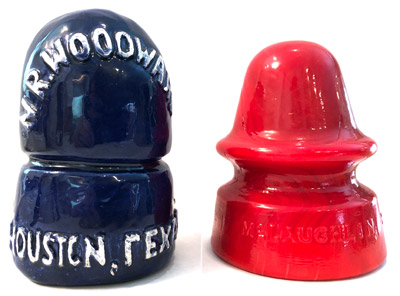 When I returned the next day, Woody showed me two insulators. The first was a hand-made, blue glazed, clay insulator of the CD #145 style. It was crown arc embossed: “N R. WOODWARD”, and on the skirt: “HOUSTON, TEXAS, ’68”. Woody told me that Francis Terrill made it for him as a gift. The base has a signature that looks nothing like Terrill but does appear to have two l’s in it. The pin hole is threaded.
When I returned the next day, Woody showed me two insulators. The first was a hand-made, blue glazed, clay insulator of the CD #145 style. It was crown arc embossed: “N R. WOODWARD”, and on the skirt: “HOUSTON, TEXAS, ’68”. Woody told me that Francis Terrill made it for him as a gift. The base has a signature that looks nothing like Terrill but does appear to have two l’s in it. The pin hole is threaded.
The second insulator was a CD #162 style McLAUGHLIN No 19, 1897-1972 Commemorative in solid red milk. William McLaughlin had specifically made this insulator for Woody and gave it to him on one of their visits. Woody said to me, “Take them. I hope you will appreciate them as much as I do” I did, and I do.
Woody’s earliest memories were of insulators. He recalled being two or three years old and being fascinated by the two-wire magneto line that went past the “little red cabin in the valley” where he and his mother lived at the time. He told me the types of insulators on the line, but I have no notes on it. The information is lost to my memory.
When Woody was four, he and his mother would walk into Hillsboro along the “Portland Toll Line” which ran through Forest Grove, where he lived. He told me that he could still see that line so vividly in his mind, as if he were standing under it today. It had a single ten-pin crossarm. The pole-pair insulators were aqua Hemingray-42s, the other eight insulators were purple Whitall Tatum’s (I don’t remember the CD number). For those of you who do not know, as I didn’t, Woody explained to me that the “pole pair” consists of the insulator closest to the pole on either side. This pair has the best electrical characteristics for telephone calls, because it had the least crosstalk from the other circuits.
Woody was given his first insulators at age eight (I’m sorry but I have lost the reference as to who gave them to him.) One was a broken McLaughlin No 9 (CD #106), the other was a STAR (CD #102). The colors were not specified. By this early age Woody was already and irrevocably fixated on insulators. They became his life. Wherever he was, he devoted all the time that he could spare to insulator research, the remainder was occupied with relatively short-term, low paying jobs, typically with a railroad. This allowed him to combine research with sustenance.
Woody lived a life of self-imposed privation that made homeless people weep. I never saw Woody in clothing that cost more than fifteen dollars including shoes. If you notice the photograph of Woody in his National Insulator Association Hall of Fame Award, you will see the Patagonia jacket I bought him during an unusual cold snap in Houston. Woody didn’t own a jacket, and that one lasted him for years. He said, “I love it. It wears like iron.” (Disclaimer: I do not own any stock in Patagonia.)
Woody saved every cent he could, but please do not think he was a miser. He needed every cent he had, and willingly spent them on the continuance of his research. When he had exhausted the local research opportunities, and had sufficient funds, he was off to the next town or city to continue his research, usually by riding the rails.
One time I asked him when he had last hopped a train. His answer, 1987. He said by that time Union Pacific had no qualms about arresting persons found on trains or in the yards. So he felt it was best to stop, even though he still felt perfectly capable of doing so, being only sixty.
Woody took and passed the entrance exam for MENSA, a group of snooty supercilious individuals who enjoy boasting that they have IQ’s in the top two percent of the population. I have no idea why he joined MENSA. It’s strange that I never thought to ask him. Perhaps because of his limited education, he wanted to know where he stood in the herd. Perhaps he did it for some sense of self-validation. It is just as likely that since their national office is in Arlington, Texas, he just wandered in one day and took the test. We will never know. I know that I never heard him mention it. I’m sure that he did not do it to impress anyone. I never knew Woody to care much about what people thought of him.
For many years he was responsible for mailing the Texas MENSA Chapter monthly magazine. I remember that the Post Office was always hassling him about Bulk-Rate charges for the magazine. He had to divide the magazines into different bundles according to the addresses within postal zones of the state. He really did not enjoy this unpaid responsibility, but there was no one else who was willing to do it. He continued this chore into his early eighties until he stopped driving (due to financial issues) and could no longer easily get back and forth to the Post Office.
The only reason I knew any of this was because I was at his apartment so often and saw him getting this magazine out every month. I’m also a member of MENSA. Although I hadn’t paid my dues since 1986, Woody put me on the mailing list for the magazine anyway. I joined MENSA in college. I hoped it would help me meet snooty, supercilious girls with high IQ’s and low morals. It did.
Once I asked Woody, “Why not try to test into the Triple Nine Society?” which represents the top tenth of the top one percent of the population of snoots. He said, “I’m just an old country boy from Oregon.” I believe this was the only time I ever heard Woody make a joke.
Woody was receiving a constant stream of phone calls and correspondence from people with questions about insulators. It took a significant amount of his time to find the information in his files and answer the letters. Also, the costs of long-distance calls, stamps, paper, and envelopes was not inconsequential in light of his limited income.
I told him that he needed a computer, and a printer/scanner, a word processor, some sort of database program, or at least an OCR/PDF program to manage his correspondence and files. Oh, and yes, a dreaded internet connection. I told him that I would buy the equipment, set it up, and take care of the internet bill (DSL. Remember DSL? We once thought it was fast.) Woody flatly refused.
I still remember where I was standing when he told me that his Remington Number One Typewriter (made in 1950) had worked fine for him all these years. He said that as long as the man who repaired it was still in business, or at least alive, and could find parts for it; that was what he was going to use. Sometime in the mid 2000’s the Remington typed it’s last letter and became unrepairable. Woody, not to be deterred, found and bought a Remington Number Two (Folks, you can’t make this stuff up).
As a side note in about 2005, Woody was disappointed when it became impossible to get parts for his 1933 Electrolux vacuum cleaner, the one with sled runners, not wheels. I bought him a Bissel for sixty bucks at Walmart. After I explained what “bagless” meant, and that wheels really weren’t that much of a hindrance, he seemed mollified.
Anyway, after a great deal of prodding, coaxing, cajoling, and cullet throwing, I managed to get Woody to agree to accept a computer and go on-line. Retrospectively, I should have merely removed my own appendix with a chainsaw. It would have been less painful. Teaching Woody how to use a computer was like teaching a cat to sing The Star-Spangled Banner, all three stanzas. I was there for days, and spent substantial time annually doing maintenance and repair. Of course, eventually Woody became proficient and admitted that it saved him a lot of time. I think the label that said “Remington” that I put on the case probably didn’t hurt either.
Some of you may remember that in 2002 I asked people on the ICON reflector to email Woody good wishes for his seventy-fifth birthday. Bad idea. Bad, Bad idea. He was madder at me than a wet insulator without drip-points. The gist of it was, “If I don’t care that it’s my birthday, why should anyone else?” Well I apologized for my lapse in judgement, poor taste, and inhumanity, and solemnly promised never to do it again, at least not until his hundredth birthday. He was not amused. Woody made me answer all the birthday emails he received. So, if the thank you email you got seemed a little generic, I hope you didn’t take it personally. It’s just that I didn’t know most of you, and I had a lot of them to write.
Somewhere around 1996 I got the idea that Woody should write short articles about certain interesting or obscure insulator tidbits that many collectors might not be aware of. He could then post them for the general interest of the insulator community on this newfangled thing called the web, where anyone could read them for free. You didn’t need a subscription to a magazine, and people could post comments that could be read immediately, not a month or two later. He thought this idea had merit but suggested that I should do it. When I pointed out that I didn’t know a CD #154 from a CD #155, he said not to worry. He said he would dig out the information from his files, and then I could edit it into something usable. He would then check and approve it for publication. Though we only did a handful of these articles, this system worked out well and was appreciated. They are still available as “N. R. Woodward on the Web” at Insulators.info
The last article which we worked on, but never published was about the CD #100 SURGE™ insulator. Woody wrote:
"My first personal encounter with the SURGE™ Fencer would have been in late 1952 on a ranch on Market Street Road, five miles east of Salem, Oregon. At that time the fence was in bad repair and appeared to be several years old. I picked up a lone insulator that had been dropped by one of the posts along the roadside."
For his seventy-fifth birthday I asked Woody what he would like to do, as he was getting on in years, and the future is always uncertain. He said that he would like to return to Oregon to see the places where he had grown up. He said he had not been back in fifty years.
In August 2002, I took Woody on a two-week trip to Oregon, Washington State, and Canada. He had a great time, as did I. He showed me the places he had lived. The structures are now long-gone. We even walked some lines including the “Portland Toll Line”. A few poles still stood, but we didn’t find any insulators.
We tried in vain to find anyone Woody knew from his time there. We went to the cemetery where his mother and other relatives are buried. Woody hadn’t seen his mother in decades and had never seen her grave. He showed no sign of emotion that was visible to me.
In 1933 when Woody was five years old, a massive forest fire known as the Tillamook Burn started very close to where he lived in Forest Grove. Before it ended a month later, it had spread over 400 square miles. Woody was terrified. He said, “It looked like the sky was on fire and was coming right at me. The smoke and smell were awful. I was sure I was going to die. I hid under the bed."
Salvage operations were immediately begun to harvest usable portions of the burned wilderness. Woody pointed out to me Douglas Firs, long dead from the burn, sixty to one hundred feet tall, vertical poles, mostly limbless, and a bleached-out grey. They were on slopes or other places that made it impractical to harvest them. They were known as “Grey Ghosts.” Woody had grown up with them his whole life. He said to me, “Now I am a “Grey Ghost.”
Woody and I had a business together, N. R. Woodward Associates. We bought and sold insulators, re-printed his 1988 Report, as well as producing those cardboard insulator boxes that Woody personally designed and was so very proud of.
In 2009, Woody and I had a falling out over something inconsequential. We had not spoken since that time, and that would have been the end of this story. However, this was not to be.
In September 2018 I was cleaning out my storage locker and found a sign that Woody had given me at least fifteen years before. It was from the Hemingray plant in Muncie. It was the sign that had hung over the cullet bin and read:
OUR CULLET
MUST BE CLEAN
Please Help
A photo of the sign appears on page 142 in the book
The Hemingray Glass Co. A Most Colorful History
By H.G. “BEA” HYVE (AKA Clarice Gordon)
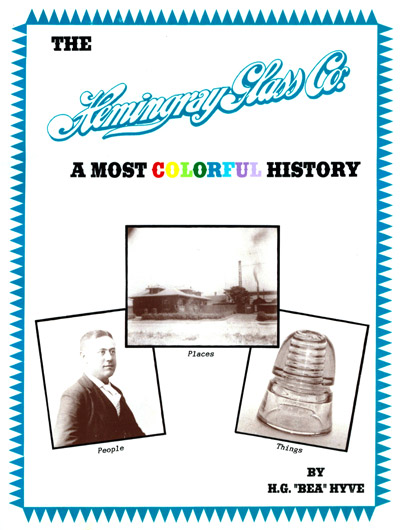
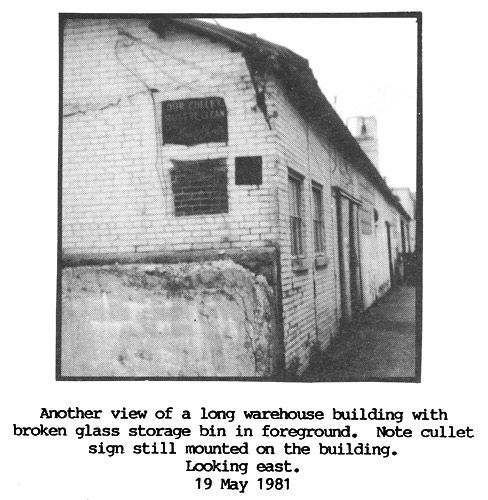
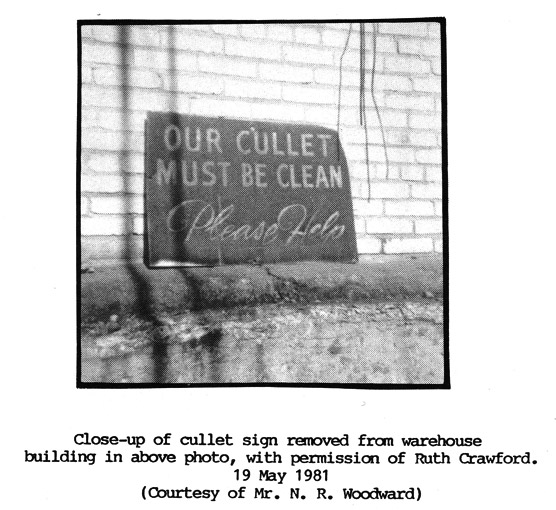
It is captioned:
“Close-up of cullet sign removed from warehouse building in above photo,
with permission of Ruth Crawford.
19 May 1981
(Courtesy of Mr. N. R. Woodward).”
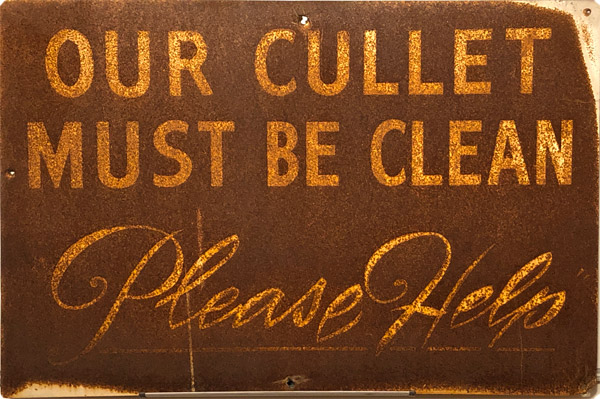
Woody made a cardboard folder to hold the sign. The folder is marked:
IF LOST, PLEASE
SEND C.O.D. To:
MARILYN ALBERS
14715 OAK BEND DR.
HOUSTON, Tx 77079
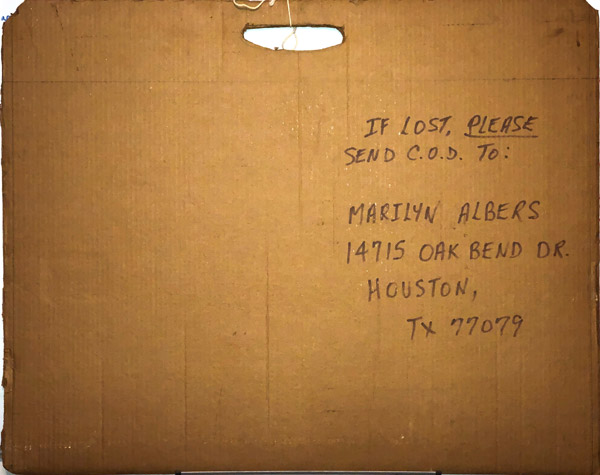
I realized the historical significance of this sign, and since I had left the hobby, I felt obligated to find it a new and proper home with some Hemingray academic. Selling it was out of the question.
The obvious way to re-home the sign would be to simply return it to Marilyn Albers. Unfortunately, she passed away in 2010. (By the way, Marilyn Albers and Sarah Lodge were two of the most gracious ladies I ever met, in and out of the hobby.)
Next I searched out Clarice Gordon. I knew that she and Woody were close friends. Unfortunately, she passed away in 2014.
Well, finally it was time to meet my worst fear and ask Woody what I should do with this albatross. One slight problem though, I didn’t know where Woody was, or even if he was alive. The internet offered no useful information about a current phone number or address.
Serendipitously, the annual Lone Star Insulator Club show was to be held in two days. What better way to find out about Woody, and hopefully see some old friends at the same time?
I went to the show and displayed the sign, and Clarice Gordon’s book showing the sign on the Hemingray building. Many people were happy to see a piece of surviving Hemingray history. Several people were kind enough to suggest individuals that I should donate the sign to. I was especially appreciative of those who did not suggest themselves.
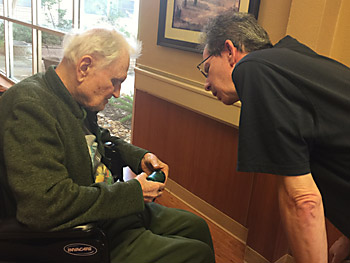 John Hall told me that Woody was in a nursing home in Houston and had some degree of dementia. He said that he had visited Woody about six months ago and that Woody was happy there. John said it was very difficult to get Woody on the phone, so my best bet would be to go visit him.
John Hall told me that Woody was in a nursing home in Houston and had some degree of dementia. He said that he had visited Woody about six months ago and that Woody was happy there. John said it was very difficult to get Woody on the phone, so my best bet would be to go visit him.
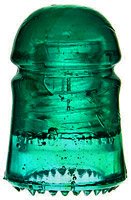 It was getting late when I left the show. I passed a table of insulators with a sign that said FREE! These were damaged pieces that I guess folks didn’t want to pack up and take home. I found a nice CD #102 BROOKFIELD, in Dark Aqua with Sharp Drip Points. About an eighth of the base was missing, but it was a nice specimen piece.
It was getting late when I left the show. I passed a table of insulators with a sign that said FREE! These were damaged pieces that I guess folks didn’t want to pack up and take home. I found a nice CD #102 BROOKFIELD, in Dark Aqua with Sharp Drip Points. About an eighth of the base was missing, but it was a nice specimen piece.
The next day, with some trepidation, and my wife holding my hand for support, we went to visit Woody. I found him sitting in a wheelchair and ambulating about using his feet for propulsion.
Woody was not wearing glasses. I remember that even in 2009, his eyesight was already poor. I believe he had macular degeneration, which only allows a person to see things in their peripheral vision. The sharp central vision is lost. I believe he may have been well near blind when we met.
Our exact conversation follows:
P: Hello Woody. Do you know who I am?
W: No who are you?
P: I’m Paul Rubin. Do you remember me?
W: No. Should I?
P: No. We met many years ago. It’s not important.
At this point I took the CD #102 insulator that I had taken from the show and placed it in Woody’s hand.
P: What is this?
W: It appears to be an insulator.
P: What is its CD number?
W: 102
P: Who made it?
W: BROOKFIELD.
P: What is this number on the crown?
W: That’s not the crown. That’s the dome. It’s a shop number.
P: When do you think it was made?
W: About 1905.
P: How do you know that?
W: It has the sharp drip-points that Brookfield only introduced at the end of production.
It was at this point that I broached the reason that I had come to talk to Woody after all these years of estrangement. I wanted to know what I should do with the Hemingray sign. I asked him about it, but he had no memory of the sign. I told him that he had written on the folder that if lost, it should be sent to Marilyn Albers. He said, “So send it to Marilyn.” I reminded him that Marilyn had died eight years ago. He teared up and said “No that can’t be. Bill Albers is my best friend and he would have told me.” I quickly said that I must have made a mistake and was thinking of someone else. He told me to do whatever I thought was best with the sign.
I asked Woody if he remembered when we went back to Oregon in 2002. He did not.
I asked if he remembered the “Portland Toll Line.” He did.
I asked him if he remembered “the little red cabin in the valley” He did.
I was told that Woody had no insulators in the nursing home.
I asked Woody if he would like to keep the insulator. He said, “Oh yes. Very much.”
It is very likely that this was the last insulator Woody handled in his life.
If anyone out there remembers leaving that insulator on the FREE table at the 2018 Lone Star Insulator Club show, please contact me. I would really like to meet you. Your act of kindness made N. R. Woodward very happy. (Update: I had been making inquiries of some of the people I knew who were at the Lone Star Insulator Club Show in 2018. An individual contacted me to let me know that he had left the insulator on the Free table. He wishes to remain anonymous but was very happy to learn that Woody enjoyed the insulator.)
After Woody died, I tried to recover the insulator. I was told that the insulator was given to a maintenance person at the nursing home. Bill Albers crucifix also mysteriously disappeared. Unfortunately, these things happen. I hope the insulator is appreciated wherever it may be, and that Bill’s crucifix gives comfort to someone.
After a short, but pleasant visit, Woody and I parted. I was happy that Woody was comfortable in the nursing home. I was saddened that he did not remember me. But then I was gladdened when I realized that from Woody’s point of view, he remembered the things that were always most important to him, insulators, not people.
I recalled something Woody had written, when we had done an article for “N. R. Woodward on the Web” fifteen years ago titled, “Just Another Hemingray-42, or is it?”
“Mr. Woodward dates these pieces to 1927. When I asked him how he could do this, he wrote:
"When you have examined thousands of insulators you just know. I base it on style, color, quality of the workmanship, as well as slight changes in embossing that occurred over time, either because of changes in the embossings, or degradation in the quality of the embossing on the insulator as the molds wore. To me an insulator is like a face. It's hard to describe the myriad of details, but if it's someone you know, every time you see him you immediately recognize him without really knowing how."
Well Woody didn’t recognize my face anymore, or Dario’s, or Marilyn’s, or those of so many others who had been dear friends, but that didn’t matter.
He still recognized the faces of his life-long friends, Brookfield, Hemingray, dozens of others, and of course William McLaughlin.
When we went on our trip in August 2002, I wanted to go to Salem, to see the place where Woody first encountered that SURGE™ CD #100 insulator back in 1952.
This time we drove, rather than walked to Market Street Road. The farm is abandoned. The fence is long gone. All that remained as we stood by the roadside on that sunny summer day was a wry smile on the face of an old man who remembered a time half a century before; a time when on any of the myriad roads, lines, or railroad right of ways, a young man could walk unhindered, and glance at glass that no one before had thought worth a second glance. That moment was worth more to me than all the insulators in the world.
In the introduction to his 1988 Report, N. R. Woodward wrote:
“The glass insulator is no longer the common sight it had been along virtually every road and railroad right-of-way only a few years ago. Open wire telephone circuits can be found in some of the more isolated areas, and many miles of railway are still flanked by the familiar block signal and communication lines. However, it is been more than ten years since the last glass pin-type insulators were manufactured in this country. The old lines are disappearing from our landscape.”
Woody wrote those words in 1988. Today, thirty years later, glass insulators haven’t been made in this country for forty-four years; and the old lines may have completely disappeared from our landscape.
If there is anyone out there who knows where there is still a working open-wire telephone line, please let me know. I would like to see it before the last of the last of the old lines disappear from our landscape.
For all his accomplishments, N. R. Woodward was a man who did not want to be remembered. Woody made it clear to me and others that we should remember the Consolidated Design system he had worked so hard to develop and remember and make use of the research he had done.
Woody also made it clear to me and others that he believed that separate from his research, he was a person of no importance, and that when he was gone, he would be just as happy if the world would forget him.
Woody stated explicitly in his will that he wanted no memorial. He donated any body parts usable to science, the remainder to be cremated, and his ashes scattered over the former MKT (now Union Pacific) line in La Grange, Texas. This wish will be carried out shortly and privately by Bill Albers, Dario DiMare, and me. The Union Pacific probably would not look fondly upon this; his final hop of a freight as it were, so we are not going to ask them.
Finally, it’s not so much that Woody is gone that amazes me. I am amazed that one man with so little was able to achieve so much.
If he had a marker, I would like it to bear the simple epitaph:
N. R. Woodward
A man who has come and gone,
Through a time that has come and gone.
Neither can ever exist again.
Even though Woody wanted no remembrance, for those of us who find this too difficult to do, I think he will forgive me these few words:
How will we remember Woody Woodward?
How can we forget him?Goodbye Woodwardo.
Goodbye you restless wanderer.
Goodbye you old Grey Ghost.
Paul T. Rubin
Houston, Texas
September 15, 2019
The article below is reprinted from "ALL INSULATORS,” formerly “Crown Jewels of the Wire," November 1971, page 11; (With kind permission of Shaun Kotlarsky).
Below Is pictured the man who originated CD (Consolidated Design) numbers and is the author of "The Glass Insulator in America". His book is a must for every serious collector who wants to trade, buy or sell by CD numbers. Consolidated Design denotes the shape and size of an insulator, and Mr. Woodward's book also shows the companies that manufactured certain insulators (or CD #'s). The first part of "The Glass Insulator In America" is devoted to the history of such companies that manufactured glass insulators. Years of study and research have gone into this book, and we, the collectors, benefit from it. For the benefit of all the new subscribers and others that might have forgotten, Mr. Woodward also offered to answer, to the best of his knowledge, your questions concerning threaded glass insulators. Send your questions to INSULATORS Crown Jewels of the Wire, and we will forward them to him to answer.
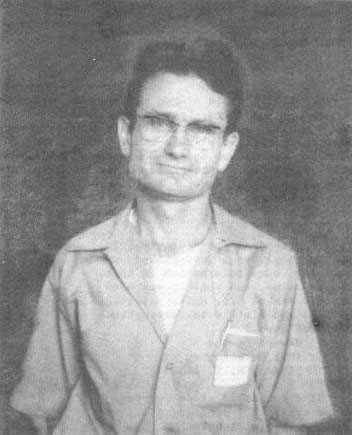
The above photo was sent in by Gerald Brown. It was taken at the Fort Scott, Kansas Meet, April 1971.
I would like to thank Maryanne Flynn, Reference Librarian, Denver Central Library for her assistance in confirming that the name of the Denver Central Library in 1961, was indeed the “Denver Central Library.” N. R. Woodward had mistakenly referred to it in a letter to me as, “Denver’s Main Library.”
I would like to thank Monique Sawyer-Lang, of the Lyons Redstone Museum, for her assistance in preparing this article, and providing photographs of the Campbell Insulator Collection. I would also like to thank her for providing me with interesting and enjoyable information about the history of Lyons, Colorado.
I would like to thank LaVern Johnson, Director of the Lyons Redstone Museum, and the “Matriarch” of Lyons, for her assistance, and reminiscences of Mr. Woodward.
I would like to thank Dario DiMare of Northborough, MA for providing me with a copy of the introduction to N. R. Woodward’s 1988 Report re-print and for his time speaking with me about his remembrances of Woody after 2009 when I was no longer in contact with him. I would also like to thank him for caring so much about Woody, and for the considerable amount of assistance he provided Woody while Woody was still able to live independently.
I would like to thank Elton Gish of Lumberton, TX for his assistance, patience, and continual support in the preparation of this article.
I would like to thank Bill Meier of Carlisle, MA for his web design; and for formatting and hosting this article on his website as another article of the “N. R. Woodward on the Web” series.
Most of all I would like to thank my wife Laura for her constant support, encouragement, suggestions, and endless editing as I revised this article twenty times.
Copyright 2019 by
Paul T. Rubin
5646 Indigo Street
Houston, TX 77096
713 203-6555
All Rights Reserved